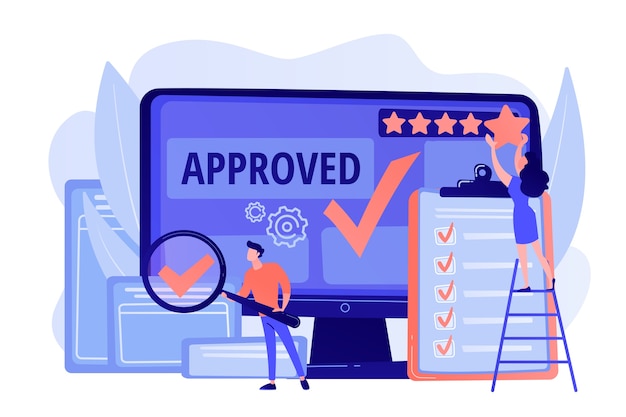Just the way you embrace all the positive reviews about your online business, you need to consider the negative reviews on business listings as well. However, it entirely depends on you if you are going to deal with the negative reviews playfully or not.

The negative reviews help you to identify the areas where you need to work more. Also, ignoring these reviews is not a good thing; rather, you should reach out to the reviewers and understand their problems to offer them the best solution and change their impression about you.
What are the types of bad reviews?
As we mentioned above, for many businesses on Google Maps or even on TrustPilot, some reviews are simply listed by some customers who were disappointed in just one aspect of your product or service. But if we dig down deeply in to the reviews, there are actually a few different types of reviewers across the world for any type of business, and there’s a different approach you should take when dealing with each type of reviewer. So, here are some examples we listed on the most common type of reviewers.

Type 1: The customer didn’t like the product at all
This is the most common type of review that every business is facing and it is hard to deal with, because you can create the product but can’t make a customer like a product. You should take care the quality of your products regularly. Most of the Restaurants face these types of reviews. If the customer doesn’t like even one item from your menu, that will definitely give you a negative review in less than a day. But you can deal with it easily. What you can do is to offer them an alternative product which is of better price. In that way customer may feel happy because you’re offering him a better priced product without extra charge. Offering a discount on the bill or offering coupons for the next time visit or even offer a product for free may help sweeten the customer.
Type 2: The customer had a problem with delivery or customer service
It’s very hard to convince the customers with the service. Every customer has different preferences in the service. Some may expect instant service, some customers doesn’t want the waiters or service people to disturb them at all unless they’re called. There are situations, the customer likes the product but has an issue with the service. This applies for normal restaurant and hotel business and even for online stores or e-commerce sites. Example, people may have issues with the customer care or a shipping issue or delivery issue or a bad customer service experience.
People tend to buy only if the issue is rectified and resolved. Responding to customers should be always your top priority. Tell them the turn around time when you can resolve. You can even offer a discount, or give them coupons to satisfy them. Keep and share an alternative email or phone number where they can speak to the service person who can assist or resolve their issue in less time. Always keep an eye on the issues you get from customers and try not to repeat any of them in the future.
Type 3: The customer had an issue with your store policies
There’s a lot of difference between instore experience and online store checkout experience to the customer. If the customers visit the physical store, they experience the product or service in live so your duty is ensure the customer satisfied till they leave the store.
For online store, that is not the case. The online experience is very short and can be temperamental for the customer, If they don’t find the product what they’re looking for, within seconds the customer exit the website. Even if you give the information on your store policies — about returns and shipping costs or even delivery — on your website, the customer may not have time to read all of them. There are always issues with the delivery or returns. Communicate with the customer immediately when they raise the issue with the customer support. Follow up with them and resolve the issues at the earliest. People tend to leave negative reviews not on the products but on the business. That is a huge threat cannot be taken lightly.
No matter what type of bad review it is, as a good business, you should respond it with any of these three things:
- Ask for Sorry or Apologize
- Give a statement of your commitment for customer satisfaction
- Bring the conversation offline or on Mail.
So, if you are wondering how to handle your negative online reviews, here are some of the best ways for you.
- Think whether the review is worth paying attention to or not
Well, not all Google my business negative reviews need special attention. Some of them include complaints about your service or other minor complaints that you can easily handle with short and compact replies. In contrast, some negative reviews are vicious to ruin your day.

Also, not every review is genuine; some are just scams to break your confidence. However, it would be best to take important measures to resolve the disputes based on the reviews’ nature. Also, you are going to need significant evidence for the issue that occurred.
So, here are the factors that you should focus on before making your judgment.
- Look for what they’re saying is completely false or not. If the reviews are incorrect, then some platforms will allow you to remove them. For instance, Google’s policies opt for forbidding the reviews that are fake, off-topic, or defamatory and viciously attacks you personally. You can search for various removal policies of different platforms. However, for showcasing a better gesture, you can either leave a reply with “thanks for your feedback” or publicly disprove the false claims made against you.
- If the review is partially true and some wrongdoing has been committed on your part, it is better to reply publicly.
- In case whatever the review says is entirely true, you need to work on it to make things right and reach back to your reviewer after some days.
- Gather the factual data to build up your thoughts
After you have read the review and decided if you need to reply or not, you need to be strategic enough to retain your business’s well-being. Don’t put your response in the heat of the moment. Think properly about it.
Gather relevant information about the work, your customers’ pain points regarding your service, and the times & dates when you have worked with them. It will save you from taking any sudden action that can ruin your reputation more.
So, you can do the following while replying to your online reviews.
- First, you need to start by thanking the person for bringing the concern to your attention.
- Then, you must address the legitimate concerns discussed in the review and proceed to work on it to resolve the issue.
- It is better to maintain a very neutral attitude while dealing with the reply. Do not get emotional and stay professional while resolving the issue.
- Lastly, you can put a name, along with your reply and your phone number or email address, so that they can directly come in contact with you regarding their concern if the platform allows.
- Opt for replying privately
Your reviewer needs to have your attention; this is what has brought him/ her to your comment box.
Sometimes the minor issues can easily be solved with a simple phone call. Reach out to the reviewer and show your concern regarding their problems. Thank the consumer for bringing out the matter to your attention. Address all the issues that they are having.

You can get help from various sites like Yelp that facilitates a way in which the business owners can directly reply to the reviewers. This method will be much easy for managing minor issues. Besides, try to stay as much neutral as possible and genuine with your response.
Now, while replying privately, you should try to apply your best judgment skills. If you successfully resolve your consumers’ problem requests, tell them courteously to update their review accordingly.
However, never ask consumers to take their reviews down, as it can make them feel pressurized, which, in turn, can create a much negative impact.
- Public replies are also helpful
In some cases, public replies help others know that you care about your customers’ reviews and take action accordingly. However, while giving away public responses, you need to stay very professional instead of getting personal.
Public replies can be really bad as they can trigger the reviewer to continue replying badly, further worsening the situation. At times, some people do not certainly want any resolution, and so you cannot fix it. Thus, it becomes crucial to decide if the reviewer wants a perfect solution to a valid complaint or he/ she is just randomly letting himself/ herself go in the flow.

Never try to win over an argument with an already frustrated customer. Also, it might make you come out as a very rude professional. Instead, opt for a resolution, which will satisfy your customer’s complaint and, at the same time, maintain your good online reputation.
Always address the concerns while being a high-level professional. Focus on legitimate concerns only, and do not pay heed to the random reviews. Also, try to stay short & humble as much as possible. It may be difficult if the other side is too bitter. However, don’t lose your patience and try to give your best.
- Maintain some best habits
A few best practices can ease out the bitterness from the minds of your customers about you. Start with thanking them, no matter how negative the reply maybe. Don’t lose your calm even if the customer claims wrongly.
Also, staying logical helps in giving out proper answers. Try to opt for finding resolutions offline. And most importantly, don’t ever respond angrily; it would adversely affect your brand’s image.

Here are some of the best practices you need to maintain while handling a negative online review.
- Even with the worst of the reviewer, you need to be modest and polite.
- Never lash out, even if you’ve got valid points.
- Apply the same logic to deal with the situation you would have implemented in a face-to-face conversation.
- Work on the issue to find a resolution offline, as problems tend to get immensely enhanced online.
6. Request fake or misleading reviews be removed
There are many reviews these days are fake or misleading. If you find out that customer doesn’t have any connection with your business and added the review as a fake and misleading information. Examples of misleading reviews could include those written by the people:
- friends or family without disclosing your personal relationship
- can be your major competitor
- someone was paid to write the fake review who has not used your product or service
- a member of your staff who was fired or left the job

- If you find the reviews from any of these people, talk to them politely and remove them at the earliest. If you don’t get positive response, make sure you report to the concerned website.
7. Encourage your customers to write a review
You can always ask and encourage your customers who felt happy with your product or service to write a review. Be careful not to force, prompt or influence them by asking that they should leave only positive reviews.
You can manage online customer reviews by:
- understanding how all the review sites work, can be Google Maps, TrustPilot, Yelp or Bing Maps or any other site.
- register with Google Alerts to track mentions of your business, this will help you to identify the keywords what people are searching on your brand name
- registering with top industry review sites, and opt for special alerts when someone post a review on your business listing
- share and promote on all mediums that you are listed on review sites and providing them with details on how they can post a review
- ask your staff to put a review how they feel working at your business
- print QR Codes and give an easy way to scan and review instantly at your physical store.
How to Remove Fake Reviews from Review Sites and Google
Responding or asking the people to remove any fake negative reviews, will not be enough to handle the business listing performance. You’ll also need to remove them if you’re sure those reviews are fake. Either the business listing sites or the major search engine giants like Google doesn’t know who your true customers are, and they won’t accept a simple reason that they haven’t shop with your store. It is difficult to prove someone’s online identity, because the reviewers are from anywhere. Just signing up and finding the business and reviewing it all this process can take just a few minutes. Most of the review sites and even Google respects user’s privacy and they doesn’t provide you details at all. You have to make additional efforts to prove the fake reviewers guilty.
Once you’ve made your response, you must flag the fake review. Here’s an example from a company, snapshot taken from Google Maps:

This is how you can report fake reviews on Google Maps.
The flag will take you to the “Report a Policy Violation” popup or an individual page where you can report.
Enter your name, email address or any other detail that Google requires and select the Violation Type. Then you have to submit. Within 24-48hrs a google representative will contact you if they need more information from your side.
But just one flag or one report may not be sufficient to speed up the process. You can ask for support from your staff or your genuine customers to report the fake reviews. So that you can increase the awareness of the problem among your staff and customers too.
After the flag, you can check the status of the flagged review. Here’s how you can do:
- Log into your Google My Business dashboard.
- Go to the Reviews section.
- Select “Support” from the home menu.
- Choose a method of contact – email or phone.
- Fill out the contact information.
The dashboard will tell you should hear back within two business days.
If any Google representative mails you or contact via phone, you need to give them necessary information that the review is fake, and why it should be removed. You can let them know how it violates Google’s policies. It’s better you take necessary snapshots or threats from the customer and share those details, links or images that back up your claim. The Google team with check with the expert team and let you their feedback and the decision they made on the review that is reported.
Conclusion:
How your customers are going to behave with you is not in your hands. No matter how polite or helpful you might be, some will never admit their fault. Don’t waste your valuable time on such customers; instead, focus on other consumers’ legitimate concerns while handling online negative reviews.

